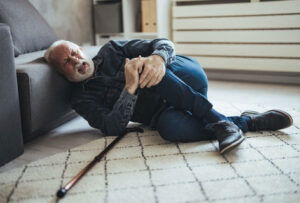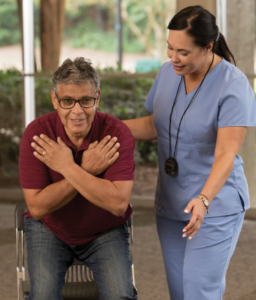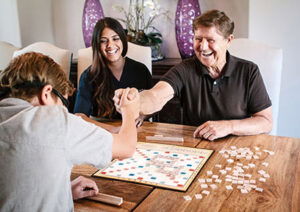As middle-aged Americans grow older, the threat of falls can become a stark reality. According to the CDC, one in four seniors aged 65 and older suffer a serious fall each year. And reports the CDC, falling once doubles a senior’s chance of falling again. Older adults become less agile and stiffer with age, putting seniors at a higher risk of suffering an injury and not being able to get up by themselves after

falling. If a family member or a caregiver isn’t immediately present, a senior lying on the ground injured for a prolonged time may suffer what’s called a “long lie fall” and possibly experience life-threatening symptoms of dehydration, hypothermia, pneumonia, pressure sores, skin or muscle damage known as rhabdomyolysis, or acute kidney failure.
Studies show that older adults and seniors became much less active during the pandemic that provoked social isolation and upended routines, causing many to lose physical conditioning and mobility. In 2021, a research team at the University of Michigan surveyed some 2,000 Americans aged 50 to 80 and found that nearly 40 percent of those over 65 reported reduced physical activity. In addition to gaining weight (about 12.5 pounds on average), many older adults reported muscle loss and a loss of balance. In resuming their exercise routines, seniors need to consider that they may not have the same agility and balance that they did a year or two ago. It is advisable for seniors to consult with their primary doctor and to proceed cautiously in rebuilding their strength and balance.
Improving strength, mobility and balance is a key strategy for reducing senior falls. It also is essential for seniors to have the necessary knowledge and skills to rise safely after a fall. What follows are some step-by-step instructions for getting up safely post-fall and suggestions for engaging in simple strength, mobility and balance exercises (remember to check with your doctor first before embarking on any new fitness routine).
Getting Up Safely After a Fall
Here are the steps that seniors should take to get up safely after a fall:
Don’t Rush: The shock of a fall can leave you feeling rattled, so take a moment to catch your breath and check if you’re injured. If you experience severe pain, suspect a fracture or have hit your head, it’s crucial to call for medical help immediately.
Position Yourself: If you feel able to get up, start by rolling onto your side. Do this by bending the leg that’s on top and lift yourself up onto your side.
Crawling to a Sturdy Object: Once on your side, get onto your hands and knees. Crawl towards a sturdy object such as a chair.
Kneeling Position: With the chair in front of you, put your stronger hand on the chair, followed by the other hand, and bring one knee forward. Make sure your hands are secure on the chair before proceeding.
Lift Yourself Up: While your hands are firmly on the chair, lift yourself up onto the chair using your stronger leg. Try to rise slowly to prevent dizziness.
Rest and Evaluate: After seated, take a few minutes to rest and evaluate. If you feel dizzy or weak, call for help. If you feel okay, slowly stand up, but stay near the chair until you’re sure you’re steady.
CLICK HERE to watch a tutorial video showing different ways seniors can get up safely after suffering a fall.
Senior Exercises to Build Strength, Mobility, and Balance

Preventing falls is equally as important as knowing how to get up safely. Here are a few exercises for seniors to enhance their strength, mobility, and balance:
Leg Strength Exercises: Activities like chair squats and leg raises can help strengthen your lower body, providing better support and balance.
Balance Exercises: Simple balance exercises such as standing on one foot, heel-to-toe walking, or Tai Chi can improve stability and reduce the risk of falls.
Stretching Exercises: Regular stretching can enhance flexibility, improve mobility, and prevent muscle stiffness, which can contribute to falls.
Aerobic Exercises: Low-impact aerobic activities like walking, swimming, or cycling can improve overall fitness and wellbeing, contributing to better balance and strength.
CLICK HERE to download the CDC’s “Steadi Older Adult Fall Prevention: A Coordinated Care Plan.”
CLICK HERE to watch these AARP animations of strength and balance exercises to try. Remember with any new exercise routine, it’s a good idea to check with your doctor first to evaluate your level of health and fitness.
How Amada Senior Care Can Help Seniors Prevent Falls and Support Senior Health
As a premier provider of non-medical, in-home care, Amada Senior Care employs trained caregivers who are committed to helping seniors preserve their independence and age safely in their own homes. Members of the Amada caregiver team are passionate about supporting seniors and their families throughout their senior in-home care journey. An Amada Senior Care advisor is equipped to guide seniors and their families on ways to stay safe at home, whether it’s through an in-home caregiver or an Amada Connect fall-alert device that immediately dispatches a designated responder in an emergency. To learn more about how we can help you or a senior loved one, please click here for a Free Care Needs Consultation.
“Safely Rising After a Fall: Tips for Seniors,” written by Michelle Flores, Amada blog contributor.















